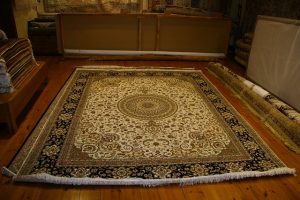Packing rugs for your upcoming relocation doesn’t seem too complicated – you just roll them up and you’re done, right? Well, not really. It’s the little things that make the biggest difference in the end. Even the tasks of packing books, clothes, and shoes for moving don’t seem like too much trouble until you skip a packing step. Or mess up the packing method altogether to end up with damaged or crushed shoes and books and ruined pieces of clothing. In this article, moving companies Bradenton FL are going to show you how to prepare rugs and carpets for moving. There are small regular area rugs that are fairly inexpensively but there are also large Persian rugs that are both very expensive and very valuable.

Follow the packing steps below to learn the best way to prepare rugs and carpets for moving
How to pack small regular area rugs
Needless to say, low-cost smaller area rugs are easier to prepare and pack than large area rugs. They are both very expensive and very large, to begin with. Luckily, if you are moving to Miami, you’ll only need three things to pack a rug for a move:
- large pieces of durable brown or Kraft paper,
- two pieces of string, twine or rope per rug, and
- packing tape.
Step 1: Prepare rugs and carpets for moving by cleaning them first
Vacuum the rug to remove any filth or even tiny bits of dirt or other matter that may be hiding in the fibers. This step is crucial because you don’t want any pests to get attracted to your rugs. For best results, leave your carpet out in the sun for a few hours before you pack it. If you have an area rug that is really stained and soiled up from years of laying in your house, consider having it cleaned professionally prior to packing. It will make your whole relocation go more smoothly.
Step 2: Determine the direction of the nap.
The fibers of any rug have a specific direction. Before you can prepare rugs and carpets for moving, you should figure out the direction of the rug pile – or nap. You can do this by rubbing your palm over the surface of the rug. You’ll notice right away that the nap responds with some sort of resistance in one direction, but they will feel smooth when you glide your hand over it in the other direction.
Step 3. Prepare rugs and carpets for moving by turning them upside down.
Before you can roll and prepare rugs and carpets for moving, you have to turn the carpet upside down so that the rug pile faces the floor. Why is this so important? If you roll your rug with the pile facing you, you are putting extra pressure on the backing of the rug. Learn more packing tips from our packing professionals. Because most fairly inexpensive rugs are stiff, this can lead to stretching and possible cracking.
Step 4. Wrap it up.
NEVER wrap your area rug in plastic. This is a common mistake when people try to prepare rugs and carpets for moving. The problem is that the plastic protective material prevents the rug from breathing traps moisture in. That leads to mold and mildew. Instead, roll your carpets in a couple of sheets of hard brown or Kraft paper. Then tape it up tightly, and you’ll be done.

How to pack oriental rugs (expensive hand-made Persian rugs)
Now, let’s take a look at how to prepare Persian rugs and large carpets for moving. If you are an owner of such a priceless carpet, you know that it has no equivalent when it comes to quality, craftsmanship, and beauty. Follow the steps below to learn how to a big 10’x13’ hand-made oriental rug in our example.
Step 3. Prepare rugs and large carpets for moving by folding them into thirds.
Grab one corner of the carpet and fold it toward the center, roughly to the middle horizontal line. Then, take the other end and pull it over the already folded part. Now your rug is folded in thirds and you get 3 layers of carpet one on top of the other. Roll the rug in a lengthwise fashion.
Step 4. Determine the direction of the grain.
As we’ve mentioned above, you’ll need to verify the direction of the rug pile to be able to pack your rug properly. Do this by rubbing your hand over its surface and then notice which motion gives you resistance and which motion feels smooth. Remember: you want to roll your large area carpet against the rug fibers (nap).
Step 5. Fold and roll the rug.
It usually takes 2 or 3 folding motions to reach the 3-foot section that you haven’t yet folded. The secret to this folding technique is that it does not place any pressure on the carpet’s foundation. It allows the carpet to roll naturally, by which it eliminates any chance of damage due to improper folding and packing.

Step 8. Tie up and wrap up the rug.
Use two pieces of string, twine, or rope to tie the carpet roll near its ends. Don’t overdo it because tightening the twine or rope too much will put extra pressure onto the rug and damage it. Again, do not use plastic when preparing Persian rugs and large carpets for moving. Instead, use durable brown paper to wrap rolled carpet entirely, then tape it up to secure and prepare rugs and large carpets for moving. After you’re done, transfer the huge handmade Persian rug into a tight package. It should measure around 3’5’’ in length and roughly 2 feet in width! This way, it will be relatively easy to move to your new home. But more importantly – it will stay safe during the relocation too.
